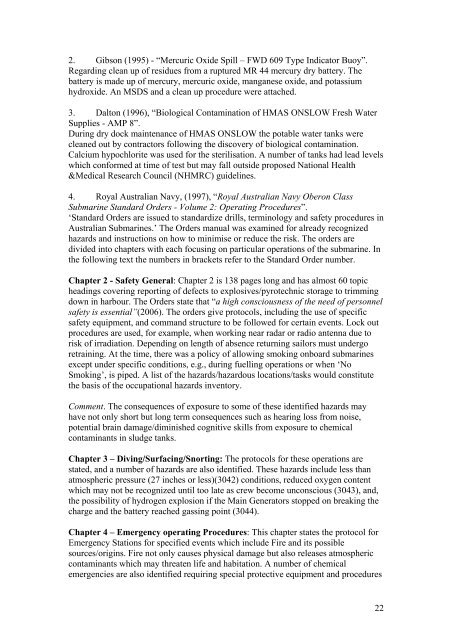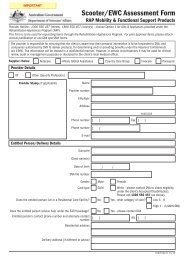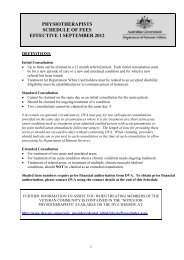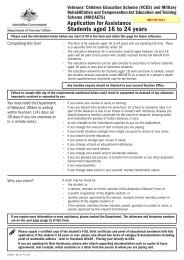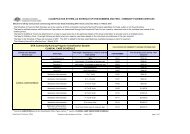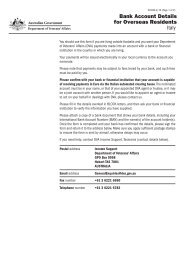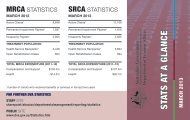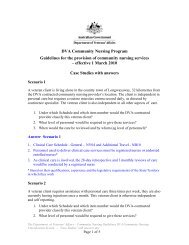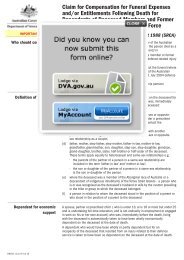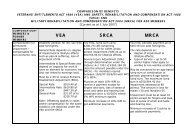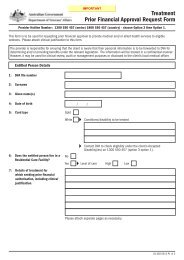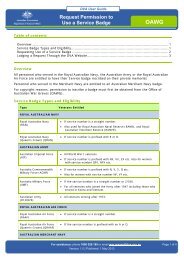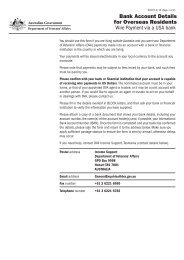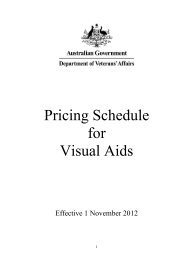2. Gibson (1995) - “Mercuric Oxide Spill – FWD 609 Type Indicator Buoy”.Regarding clean up of residues from a ruptured MR 44 mercury dry battery. Thebattery is made up of mercury, mercuric oxide, manganese oxide, and potassiumhydroxide. An MSDS and a clean up procedure were attached.3. Dalton (1996), “Biological Contamination of HMAS ONSLOW Fresh WaterSupplies - AMP 8”.During dry dock maintenance of HMAS ONSLOW the potable water tanks werecleaned out by contractors following the discovery of biological contamination.Calcium hypochlorite was used for the sterilisation. A number of tanks had lead levelswhich conformed at time of test but may fall outside proposed National Health&Medical Research Council (NHMRC) guidelines.4. Royal Australian Navy, (1997), “Royal Australian Navy <strong>Oberon</strong> <strong>Class</strong><strong>Submarine</strong> Standard Orders - Volume 2: Operating Procedures”.‘Standard Orders are issued to standardize drills, terminology and safety procedures inAustralian <strong>Submarine</strong>s.’ The Orders manual was examined for already recognizedhazards and instructions on how to minimise or reduce the risk. The orders aredivided into chapters with each focusing on particular operations of the submarine. Inthe following text the numbers in brackets refer to the Standard Order number.Chapter 2 - Safety General: Chapter 2 is 138 pages long and has almost 60 topicheadings covering reporting of defects to explosives/pyrotechnic storage to trimmingdown in harbour. The Orders state that “a high consciousness of the need of personnelsafety is essential”(2006). The orders give protocols, including the use of specificsafety equipment, and command structure to be followed for certain events. Lock outprocedures are used, for example, when working near radar or radio antenna due torisk of irradiation. Depending on length of absence returning sailors must undergoretraining. At the time, there was a policy of allowing smoking onboard submarinesexcept under specific conditions, e.g., during fuelling operations or when ‘NoSmoking’, is piped. A list of the hazards/hazardous locations/tasks would constitutethe basis of the occupational hazards inventory.Comment. The consequences of exposure to some of these identified hazards mayhave not only short but long term consequences such as hearing loss from noise,potential brain damage/diminished cognitive skills from exposure to chemicalcontaminants in sludge tanks.Chapter 3 – Diving/Surfacing/Snorting: The protocols for these operations arestated, and a number of hazards are also identified. These hazards include less thanatmospheric pressure (27 inches or less)(3042) conditions, reduced oxygen contentwhich may not be recognized until too late as crew become unconscious (3043), and,the possibility of hydrogen explosion if the Main Generators stopped on breaking thecharge and the battery reached gassing point (3044).Chapter 4 – Emergency operating Procedures: This chapter states the protocol forEmergency Stations for specified events which include Fire and its possiblesources/origins. Fire not only causes physical damage but also releases atmosphericcontaminants which may threaten life and habitation. A number of chemicalemergencies are also identified requiring special protective equipment and procedures22
to avoid short and long term effects. Those involved in fighting fires are ordered toprotect themselves by wearing thermaguard suits, Kevlar gloves, anti-flash gear plusreducing skin exposure and spark entry points on their own clothing (4019).(Comment: Prior to use of Kevlar it is likely that asbestos gloves and blankets wereused.) If external organizations became involved in an emergency, simple linedrawings of submarine layout were available. Clean up, testing for cleanliness andfirst aid procedure for spills of torpedo propellant Otto Fuel are documented. Theprocedure of torpedo ‘hot running’ is also documented together with testing of foreends/accommodation space for HCN (5 ppm), NO 2 (0.5 ppm), H 2 (3%), CO (15 ppm),and CO 2 (0.8%) using appropriate Dräger detector tubes and followed by testing forOtto Fuel (0.2 ppm) with its own special tester (4123). The submarine carries a rangeof pyrotechnics which may be fired from a submerged submarine (4125) and smokecandles (4127). Asbestos blankets were a part of the fire fighting equipment (4126)used in controlling an accidental ignition. Some of the smoke candles (white) are baseon calcium phosphide which will release a highly toxic gas, phosphine (4128). Thered and green grenades are based on magnesium plus additives to produce the colour.Other substances used in markers, beacons or bubble decoys are fluorescine andlithium hydride. The latter presents risks of fire and corrosive residues when incontact with water. Each submarine carries six Emergency Atmosphere Monitoringkits (EAM) which contain a Dräger pump and packet of tubes for each of thefollowing: carbon monoxide, carbon dioxide, hydrocyanic acid, hydrochloric acid,phosgene, oxygen, chlorine and an EAM chart (4135). The report provides a tablewhich lists the MPC concentrations for Normal, 24 hours, 1 hour, Out/SPEC and thenumber of pumps.Comment. The table has two errors. First the MPC Normal for phosgene should be 0-0.05 vpm instead of 0-0.5 vpm, and the second is the unit of measurement for carbondioxide should be percent (%) and not vpm. The use of ‘vpm’ instead of ‘ppm’ maybe confusing when referencing other information sources.Chapter 5 – Miscellaneous Procedures/Incidents. This chapter covers a broadrange of topics including transfer of personnel between ships and helicopter (requiringearthing to reduce electrostatic shock) and disposal of rubbish via gash bag ejector ortorpedo tubes. In an event of a nuclear attack, a range of radiation detectors arecarried and protocols for use are documented.5. Flynn, (1997), “Toxic Gas Incident Onboard HMAS ONSLOW - Provision ofMedical Information to the RN”.This report was produced in response to a request for medical information following atoxic gas incident on HMAS ONSLOW which occurred on 1/5/1981. The reportprovides an attachment with a list of symptoms and the number of crew affected.Forty three out of a crew of 66 were affected. No details about the incident arepresented.6. Maron, (1999), “Unclassified: - PCB Exposure in HMAS OTAMA”.This report provides information on the potential health effects of exposure to PCBsfollowing an exposure to smoke/vapour from heating two capacitors though to containPCBs. Exposure may have been through inhalation and/or skin contact during theclean up stage. The minute writer was unaware whether any one was affected, butadvises the crew members who were exposed or think they may have been exposed to23
- Page 1 and 2: Oberon Class SubmarineOccupational
- Page 3 and 4: ContentsExecutive Summary..........
- Page 7 and 8: There is strong anecdotal evidence
- Page 10: decommissioned) in 1992. The five r
- Page 13 and 14: Ventilation Arrangements(from Kane
- Page 15 and 16: Approach Adopted in this StudyIn or
- Page 17 and 18: Departmental DocumentsDefence Scien
- Page 19 and 20: of diesel-electric propulsion and a
- Page 21: 4. Gan & Mazurek (~ 2005), “Expos
- Page 25 and 26: from the air vents, in excess of 65
- Page 27 and 28: Overseas Studies Relating to Oberon
- Page 29 and 30: For the compounds identified with *
- Page 31 and 32: pollution by 33%. There is a length
- Page 33 and 34: Air Quality Standards1. In his brie
- Page 35 and 36: Continuous Exposure Guidance levels
- Page 37 and 38: ClothingStandard orders refer to th
- Page 39 and 40: occupational health exposure studie
- Page 41 and 42: Issues of body absorption of diesel
- Page 43 and 44: eading time is 10 minutes. The 0.2
- Page 45 and 46: Comment. This study is cited as the
- Page 47 and 48: • secrecy associated with submari
- Page 49 and 50: 3-methyl hexanedimethylcyclohexane1
- Page 51 and 52: - performance of tasks in cramped c
- Page 53: smoke candles ·torpedo 'hot runnin
- Page 56 and 57: The control room onONYX, looking af
- Page 58: Committee and the University of Que
- Page 61 and 62: Many references were made to a sens
- Page 63 and 64: safety was compromised for speed an
- Page 65 and 66: Health HazardsThe health hazards id
- Page 67 and 68: Psychological• Stress caused by n
- Page 69 and 70: Tar epoxiesJason pistols?berylliumE
- Page 71: Some of the psychological effects i
- Page 75 and 76:
Table 3: Rank and job description b
- Page 77 and 78:
Junior SailorsEngineeringTradespers
- Page 79 and 80:
Seaman- maintainerelectricalLeading
- Page 81 and 82:
Table 4: Exposure Profile and Quali
- Page 83 and 84:
DiscussionThis project appears to b
- Page 85 and 86:
in surface vessel engine rooms. The
- Page 87 and 88:
exceeded the guideline of 50 microg
- Page 89 and 90:
ConclusionIn conclusion, the occupa
- Page 91 and 92:
AnnexesAnnex A: The Project TeamAnn
- Page 93 and 94:
Annex B toOberon Class SubmarineOcc
- Page 95 and 96:
locked cabinets at CMVH and accesse
- Page 97 and 98:
THIS PAGE WILL BE DETACHED FROM YOU
- Page 99 and 100:
• What were the specific tasks co
- Page 101 and 102:
List of Documents not AvailableAnne
- Page 103 and 104:
ReferencesLiterature ReviewAdelson
- Page 105 and 106:
Gorman R., Liss G.M., (1985), “Oc
- Page 107 and 108:
McKinnery, W. N., Jr. and Moore, R.
- Page 109 and 110:
Aeronautical and Maritime Research
- Page 111:
111


